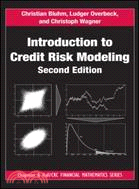| FindBook |
有 1 項符合
Introduction to Credit Risk Modeling, Second Edition的圖書 |
 |
Introduction to Credit Risk Modeling, Second Edition 作者:Bluhm,Christian/Overbeck,Ludger/Wagner,Christoph 出版社:Taylor & Francis 出版日期:2010-06-03 語言:英文 規格:16.5 x 24.1 x 2.5 cm / 普通級/ 雙色印刷 / 再版 |
| 圖書館借閱 |
| 國家圖書館 | 全國圖書書目資訊網 | 國立公共資訊圖書館 | 電子書服務平台 | MetaCat 跨館整合查詢 |
| 臺北市立圖書館 | 新北市立圖書館 | 基隆市公共圖書館 | 桃園市立圖書館 | 新竹縣公共圖書館 |
| 苗栗縣立圖書館 | 臺中市立圖書館 | 彰化縣公共圖書館 | 南投縣文化局 | 雲林縣公共圖書館 |
| 嘉義縣圖書館 | 臺南市立圖書館 | 高雄市立圖書館 | 屏東縣公共圖書館 | 宜蘭縣公共圖書館 |
| 花蓮縣文化局 | 臺東縣文化處 |
|
|
- 圖書簡介
Contains Nearly 100 Pages of New Material
The recent financial crisis has shown that credit risk in particular and finance in general remain important fields for the application of mathematical concepts to real-life situations. While continuing to focus on common mathematical approaches to model credit portfolios, Introduction to Credit Risk Modeling, Second Edition presents updates on model developments that have occurred since the publication of the best-selling first edition.
New to the Second Edition
An expanded section on techniques for the generation of loss distributions
Introductory sections on new topics, such as spectral risk measures, an axiomatic approach to capital allocation, and nonhomogeneous Markov chains
Updated sections on the probability of default, exposure-at-default, loss-given-default, and regulatory capital
A new section on multi-period models
Recent developments in structured credit
The financial crisis illustrated the importance of effectively communicating model outcomes and ensuring that the variation in results is clearly understood by decision makers. The crisis also showed that more modeling and more analysis are superior to only one model. This accessible, self-contained book recommends using a variety of models to shed light on different aspects of the true nature of a credit risk problem, thereby allowing the problem to be viewed from different angles. - 作者簡介
Over the years, Christian Bluhm has worked for Deutsche Bank, McKinsey, HypoVereinsbank’s Group Credit Portfolio Management, and Credit Suisse. He earned a Ph.D. in mathematics from the University of Erlangen-Nürnberg.
Ludger Overbeck is a professor of probability theory and quantitative finance and risk management in the Institute of Mathematics at the University of Giessen. During his career, he worked for Deutsche Bundesbank, Deutsche Bank, HypoVereinsbank/UniCredit, DZBank, and Commerzbank. He earned a Ph.D. in mathematics from the University of Bonn.
Christoph Wagner has worked for Deutsche Bank, Allianz Group Center, UniCredit/HypoVereinsbank, and Allianz Risk Transfer. He earned a Ph.D. in statistical physics from the Technical University of Munich. - 目次
The Basics of Credit Risk Management Expected Loss Unexpected Loss Regulatory Capital and the Basel Initiative
Modeling Correlated Defaults The Bernoulli Model The Poisson Model Bernoulli versus Poisson Mixture An Overview of Common Model Concepts One-Factor/Sector Models Loss Dependence by Means of Copula FunctionsWorking Example on Asset Correlations Generating the Portfolio Loss Distribution
Asset Value Models Introduction and a Brief Guide to the Literature A Few Words about Calls and Puts Merton’s Asset Value Model Transforming Equity into Asset Values: A Working Approach
The CreditRisk+ Model The Modeling Framework of CreditRisk+ Construction Step 1: Independent Obligors Construction Step 2: Sector Model
Risk Measures and Capital Allocation Coherent Risk Measures and Expected Shortfall Contributory Capital
Term Structure of Default Probability Survival Function and Hazard Rate Risk-Neutral vs. Actual Default Probabilities Term Structure Based on Historical Default Information Term Structure Based on Market Spreads
Credit Derivatives Total Return Swaps Credit Default Products Basket Credit Derivatives Credit Spread Products Credit-Linked Notes
Collateralized Debt Obligations Introduction to Collateralized Debt Obligations (CDOs)Different Roles of Banks in the CDO Market CDOs from the Modeling Point of View Multi-Period Credit ModelsFormer Rating Agency Model: Moody’s BET Developments, Model Issues, and Further Reading
References
Index
|











